|
FAQs about Stony Coral, Cnidarian
Identification 10
Related FAQs: Stony Coral ID 1, Stony Coral ID 2, Stony Coral ID
3, Stony
Coral ID 4, Stony Coral ID 5,
Stony Coral ID 6, Stony Coral ID 7, Stony Coral ID 8, Stony Coral ID 9, Coral ID 11, Coral ID 12, Stony Coral ID 13, Stony Coral ID 14, Stony Coral ID 15, & Cnidarian
Identification, Stony FAQs 1, Stony
FAQs 2, Foods/Feeding/Nutrition, Disease/Health, Propagation, Coral Compatibility, Stony Coral Behavior,
Related Articles: Stony
Corals,
|
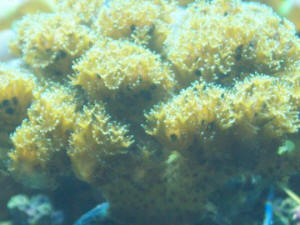 |
|
Another hitchhiker ID please - 10/06/2009
Hello crew,
<Howdy>
First, thank you for your previous help on IDing Dendros on our
LR. We have been feeding them daily and they are growing. We
counted about 20 total!
After we started getting a handle on the Dendros we noticed that
another coral on the same rocks (3 rocks, each rock has both
types of coral, not present anywhere else in the tank but these
3). When we first put it in
the tank we thought they were skeletons, but they have begun
sprouting tentacles. After our Dendro experiences we experimented
with feeding them directly as well and sure enough they are now
growing. We would like to see if we can figure out what these are
so that we can take care of them properly as well. We are not
sure if they are photosynthetic or not.
Thanks for your help,
Nicki
<... this is quite unusual... I do think this may be a
Blastosmila. Is that a big ole crab claw in the backgd.?
Bob Fenner>
|
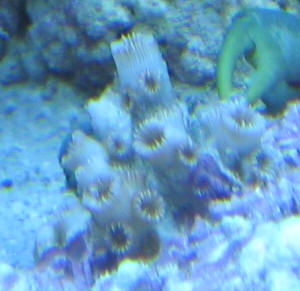 |
|
Re: Another hitchhiker ID please
10/7/09
Yes that is a Emerald claw in the background
<A big boy!>
. He got moved to the fuge. We got him to take care of some
bubble algae.
He was eating that plus things we really did not want him ripping
off the rocks. Those emeralds really like tubes. He would grab
them by the clawful and throw them into the air. Amusing, but not
reef friendly.
<Ah yeah. My long-standing position re
Mithraculus/Mithrax>
The mystery guest looks a lot like Archohelia rediviva,
<Mmmm, maybe>
but that is supposed to be extremely rare in tanks
<Is>
and the color is black instead of brown like we have. However if
you took black and white photos of the 2 they look exactly the
same. It has also now been suggested that is might be cladocora.
Cladocora has the correct coloring, but the shape is a little
off. If you combined the shape and tentacles of the AR with the
color of the Cladocora it would be it. When I searched
Blastosmila I only found pictures of skeletons. Do you know what
the coloring usually is on those and if they are photosynthetic
or not?
<Unfortunately, no>
Thanks for your help on our mysterious hitchhiker,
Nicki
<A keeper in any case! BobF>
|
|
Help with coral ID -- 08/14/09
Hi Bob,
<Chris>
A friend gave me the coral in the attached pic, but I am having a
Dickens of a time ID'ing it. I'd appreciate any help
(family, genera, etc) that you all can provide.
Best,
Chris
<A Pectiniid of some sort:
http://wetwebmedia.com/pectiniids.htm
BobF>
|
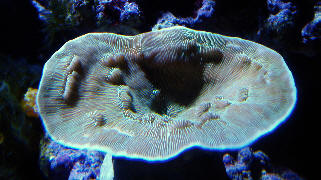 |
Coral ID 5/21/09
Bob,
<James here, for the vacationing Bob, mixing work with
pleasure.>
We received another shipment from Jakarta, and the packing slip was
very vague on descriptions(Acropora Exotic was most of the id's.)
If I sent you guys some close-up photos, is there someone in your crew
that could ID them for us.
Any help or direction would be appreciated very much.
<Likely, you will be able to ID going here.
http://www.wetwebmedia.com/acropori.htm. If not found there,
go here. http://www.livestockusa.org/CORALS.html James (Salty
Dog)>
E & T Rood
|
Live Rock ID 5/5/09
Hi Crew,
<Roxanne>
I've read your web site for months as we set up our saltwater
tanks.
We've had tanks for about 35 years on and off, but things
have changed dramatically. That's most likely from folks like
you who have disseminated useful and valuable information to this
hobby. Kudos for the great work.
<Thank you>
Now for my question.......
I purchased some live rock which I think came from the Florida
Keys.
It's filled with polyps, sponges and the critter I'm
trying to ID here.
They stand about 1/4 inch off the rock, though the smallest are
still barely above the surface. Even the smallest send out the
polyps you see in the 2nd picture. I'm just curious if you
have any idea what they may be? (Sorry, if the pictures are too
large. Making them small lost all detail - hindering ID.)
Thanks for your help.
Roxanne
<Mmm, given your clue as to origin... and the
prominent/distinctive features of the corallites (deep pits,
alternating protruding and smaller septa...) I do think these are
Hidden Cup Coral, Phyllangia americana
(family Faviidae)... Is mostly found "under rocks and
ledges" in the wild, and often has more color...
reddish-brown. Bob Fenner>
|
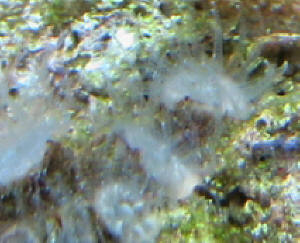 |
|
Mystery Sac I.D. 04/29/09
Good Morning,
I am hopeful you can identify this mystery sac, that , on closer
inspection, seems to have a string (of eggs) inside it.
<In my opinion, no, this is not eggs. To me, this looks like a
"swollen" feeding tentacle with a mesenterial
filament.>
It is attached to what I believe may be a dead chalice coral
(free with purchase of neighboring coral!). I've inset a
closer view, but it is quite transparent, about an inch long,
with a small opaque tip and it is
difficult to photograph.
Thanks for your kind assistance. I tried Googling 'sac of
eggs' or 'sac of water' without any good results, as
you well might imagine.
<Again, to me, it looks like a swollen feeder. But I don't
know why the tentacle might be swelling like that (maybe
irritation, stress, etc...or maybe just no "good"
reason at all). Some Euphyllia sp (and other) corals
do release eggs from their tentacles (which you can actually see
in the tentacles before they are released). However, that's
not what this looks like to me.>
Reef Tank residents: 2 juvenile Picasso Clowns, 1 Midas Blenny, 1
Blue Spotted Jawfish, 2 Cleaner Shrimp, 3 Glass Shrimp, 1 Lettuce
Sea Slug, 1 Turbo Snail, 1 Tonga Fighting Conch, 1 Blue-legged
Hermit (uninvited), 1 uninvited crab of unknown type, and about 7
corals of various types.
P.S. If this coral is indeed dead (my LFS did not know), I
assumed it would begin to degenerate, and I would then remove it,
but it has looked unchanged for about two months now, as I
decided to wait and watch. Is this prudent?
<Yes... for now, the coral does not look unhealthy to
me.>
Thanks again for any suggestions you might have.
Lianne
<De nada,
Sara M.>
|
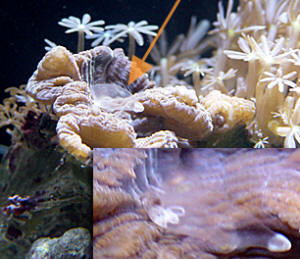 |
|
Coral ID - Catalaphyllia jardinei or not Catalaphyllia
jardinei? 4/29/09
Gentlemen!
<Mmm, have sent to SaraM for her better analysis>
Please find attached a few pictures of a species that I think may
be Catalaphyllia jardinei. I am however seeking your view on its
identification.
<Mmm... might be, but I don't think so>
The block of heads is circular with a diameter of 2 inches. The
heads are very close together and have individual heads with
diameters of 1/3 of an inch. The discs are all uniformly bright
green and the tentacles are grey to white in colour. The tentacle
tips are white under my lighting conditions.
There is a sharp septa between each head, which is only visible
when the discs are very retracted or out of the water.
This species is placed about 3 inches under the water
surface.
<Not the habitat of Catalaphyllia...>
The light is a combination of 10,000k VHO (2 x 24W) and white and
actinic LEDs. Water circulation is strong for the size of the
tank, but does not hit the species directly. Water quality is
pristine (dixit my tests) with regular water changes and
overskimmed with ozone. The species had been thriving in my tank
for over 6 months, not being specifically fed,
<Needs to be>
but grabbing a Mysid or Artemia shrimp on occasion.
Your help in identifying the species is greatly appreciated!
Thank you &
Best regards,
Tim
<Appears to be a starved Duncanopsammia axifuga to me more
than anything...
I'd be reading re its needs, meeting them. Bob Fenner>
|
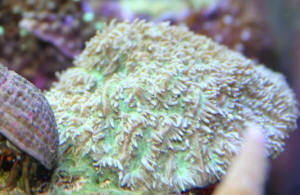 |
Re: Coral ID - Catalaphyllia jardinei
or not Catalaphyllia 4/29/09
jardinei?
Hi Bob,
<Tim>
Thank you for your reply. However, my expectation is for
Duncanopsammia axifuga to have stem/trunk where each of the heads
individually attaches, like hammerheads.
<You are correct. Both are meandroid in morphology>
This is not the case with the species in my tank: every head is
closely attached to the other and only separated by a sharp septum,
and the coral attaches directly to the rock.
<Oh! Sorry re... Is not obvious to me in the images>
But here again, I am a total beginner in coral taxonomy!
The other comment that I would make is that the species is very
high in the tank because that is where I chose to put it - and it
does seem to be faring quite well so far. Anyway, I will do more
research into Duncanopsammia axifuga.
Thank you &
Best regards,
Tim
<Let's wait on SaraM's better experience here. In the
meanwhile, If you can send along a larger image (1 mb let's
say) better resolved... perhaps taken from the surface down... with
the pumps shut off temporarily. Bob Fenner> |
|
Re: Coral ID - Catalaphyllia jardinei or not
Catalaphyllia jardinei? Sara M and Jake Adams input --
4/29/09
Hi Bob,
<Tim>
Thank you for your reply. However, my expectation is for
Duncanopsammia axifuga to have stem/trunk where each of the heads
individually attaches, like hammerheads.
<You are correct. Both are meandroid in morphology>
<<Hmm... I don't think this is a Duncan, but I do agree
with Bob that it does appear meandroid. Maybe a Platygyra
sp.?>>
This is not the case with the species in my tank: every head is
closely attached to the other and only separated by a sharp
septum, and the coral attaches directly to the rock.
<Oh! Sorry re... Is not obvious to me in the images>
But here again, I am a total beginner in coral taxonomy! The
other comment that I would make is that the species is very high
in the tank because that is where I chose to put it - and it does
seem to be faring quite well so far. Anyway, I will do more
research into Duncanopsammia axifuga.
Thank you &
Best regards,
Tim
<Let's wait on SaraM's better experience here.>
<<Ha. I'm a "beginner" in coral taxonomy
myself... but I think better pictures (ones of the coral
completely retracted, showing the skeleton better), would be
helpful. Till then, my "best guess" is Platygyra sp. If
only I had my Veron books handy here... bunk!>>
<In the meanwhile, If you can send along a larger image (1 mb
let's say)
better resolved... perhaps taken from the surface down... with
the pumps shut off temporarily. Bob Fenner>
<<Ditto. Sara M.>>
Ok... forget what I just said. I just asked Jake Adams for
help. He says it's a Hydnophora pilosa... and unless pics of
the skeleton show any different, I have to agree with him.
Cheers,
Sara M.
Re: Coral ID - Catalaphyllia jardinei or not
Catalaphyllia jardinei? -- 4/29/09
PIC4
<Tim, please see my last e-mail. You absolutely must resize
your images to ~500 KB. I've had to delete your original
images -- all of them -- because they're blocking our 10 MB
e-mail allowance. In doing so, they're bouncing back other
people's messages, which isn't fair. Resize your images,
and then send them again. We do specifically ask for this from
everyone who writes, as you'll see on the page where you got
the Crew e-mail address.
Cheers, Neale.>
Re: Coral ID - Catalaphyllia jardinei or not
Catalaphyllia jardinei? -- 4/29/09
Apologies for this,
I sent the pics in large format as requested by Bob in his
earlier email,
<<This is so. Sorry, I should have asked for just one
image... or had you send them to my personal email... which you
eventually did. RMF>>
but will get them resent to you in a smaller format ASAP.
Best
Tim
<Hi Tim, one big image isn't so bad, but eight of them,
each over 4 MB
each, simply blocks everything else getting to us. For screen
work (as
opposed to print) then 72-96 dpi is fine, and resized to 640 x
480 or 800 x
600 should be ample. If all else fails, crop away everything that
isn't
relevant. Thanks for understanding. Cheers, Neale.>
|
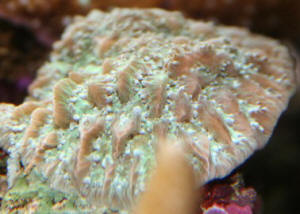 |
Re: Coral ID - Catalaphyllia jardinei
or not Catalaphyllia jardinei? -- 4/30/09
I went to look at pics of H pilosa, and it does look very
similar
(http://www.meerwasser-lexikon.de/tiere/657_Hydnophora_pilosa.htm).
In my situation, it is an encrusting type of LPS.
I am currently not in a position to send resized pics now, but will
do so at the earliest opportunity.
Best regards,
Tim
<And you. BobF>
Re: Coral ID - Catalaphyllia jardinei or not Catalaphyllia
jardinei? -- 4/30/09
Resized pics attached. reasonably sized...
Best
Tim
<Ah yes... I clearly see the skeletal hydnophores here. Bob
Fenner> |
|
What is this coral? 4/2/09
Hello,
<Hi there Teresa>
I have read on your site extensively. It has helped me in so many
ways, I am truly grateful. I purchased this coral and I did not
research it before hand. I know I should have but the pet store
man who is their saltwater specialist has sold me most of my tank
inhabitants and is usually right on. The trouble is I forgot the
name of it and cannot find it on the site. I think it maybe so
sort of Porites.
<Perhaps>
I remember it started with a D but I would love to know how to
feed it and care for it.
<Please read here:
http://wetwebmedia.com/poritidfdgfaqs.htm>
He said it was not aggressive so it is in the middle of a 155 bow
with mega flow 2 sump 3 250w MH and 6 blue bulbs. I feed oyster
eggs and rotifer 2x a week. Tank numbers are good.
Thanks for any help you may have
Teresa
<If you have time, interest in a more sure answer/ID, please
make and send along a more-resolved (larger file, close-up) pic.
Bob Fenner>
|
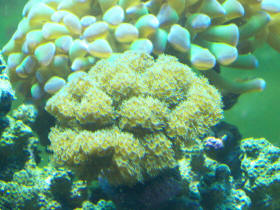
|
Re: What is this coral?
04/02/09
Thanks for your reply Bob, and I hope you are doing well
today!
<Thank you my friend. Am trying. BobF>
Here are a few more pictures in hopes you may be able to
name this critter.
Thanks Teresa
<Oh, sorry re the incomplete resp... These new pix...
the coral polyps... the arrangement of the skeleton...
Could still be a Poritid, but... I can't say
definitively if it is or not... I would proceed with care
per this family however. Bob Fenner>
|
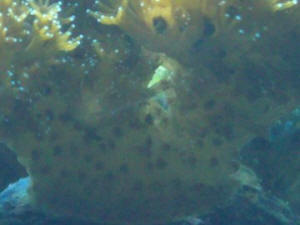  |
|
|
|

